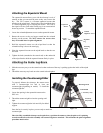
13
M
M
o
o
v
v
i
i
n
n
g
g
t
t
h
h
e
e
T
T
e
e
l
l
e
e
s
s
c
c
o
o
p
p
e
e
M
M
a
a
n
n
u
u
a
a
l
l
l
l
y
y
In order to properly balance your telescope, you will need to move your telescope manually at various portions of
the sky to observe different objects. To make rough adjustments, loosen the R.A. and DEC clutch knobs slightly
and move the telescope in the desired direction.
Both the R.A. and DEC axis have lock levers to clutch down each axis of the telescope. To loosen the clutches on
the telescope, rotate the lock levers counterclockwise.
B
B
a
a
l
l
a
a
n
n
c
c
i
i
n
n
g
g
T
T
h
h
e
e
M
M
o
o
u
u
n
n
t
t
i
i
n
n
R
R
.
.
A
A
.
.
To eliminate undue stress on the mount, the telescope should be properly balanced around the polar axis. Proper
balancing is crucial for accurate tracking. To balance the mount:
1. Verify that the telescope is securely attached to the
telescope mounting platform.
2. Loosen the R.A. lock lever and position the telescope off
to one side of the mount. The counterweight bar will
extend horizontally on the opposite side of the mount.
3. Release the telescope — GRADUALLY — to see which
way the telescope “rolls.”
4. Loosen the set screws on the side of the counterweight so it
can be moved the length of the counterweight bar.
5. Move the counterweight to a point where it balances the
telescope (i.e., the telescope remains stationary when the
R.A. clutch knobs are loose).
6. Tighten the screw on the counterweight to hold it in place.
While the above instructions describe a perfect balance arrangement, there should be a SLIGHT imbalance to ensure
the best possible tracking. When the scope is on the west side of the mount the counterweight should be slightly
imbalanced to the counterweight bar side. And when the tube is on the east side of the mount there should be a
slight imbalance toward the telescope side. This is done so that the worm gear is pushing against a slight load. The
amount of the imbalance is very slight. When taking astrophotographs, this balance process can be done for the
specific area at which the telescope is pointing to further optimize tracking accuracy.
Figure 2-13
Declination
Lock Lever
R.A. Lock Lever
Figure 2-12


















